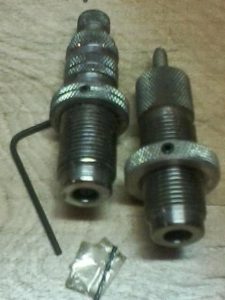 I got the reloading dies on the right in the mail as part of a mismatched lot I found on ebay. So since they’re a little gunky, missing some pieces, etc., I figured it might be a good time for a post on cleaning and restoring reloading dies.
I got the reloading dies on the right in the mail as part of a mismatched lot I found on ebay. So since they’re a little gunky, missing some pieces, etc., I figured it might be a good time for a post on cleaning and restoring reloading dies.
Whether it’s bullet lube or case lube or dust or rust, reloading dies get filled with junk. They get bent parts, they lose pieces, they get plugged up and stuff gets stuck in them. Dirty dies are not only harder to work with, they can damage your brass and reduce shooting performance.
So here’s a step-by-step on getting those dies back to tip top shape.
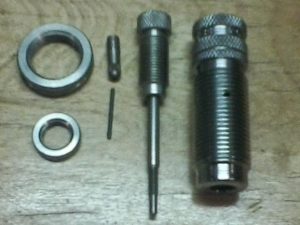 1. Take inventory. Disassemble the die and check for broken or missing parts. Is the rod bent or rusty? Is its bottom twisted or crushed where the pin enters it? Does the ball have any gouges or pits in it? Are the rings missing that little internal doohickie* that goes behind the screw?
1. Take inventory. Disassemble the die and check for broken or missing parts. Is the rod bent or rusty? Is its bottom twisted or crushed where the pin enters it? Does the ball have any gouges or pits in it? Are the rings missing that little internal doohickie* that goes behind the screw?
2. Drop everything except the pins into a sonic cleaner for 2-3 minutes.** There’s no need to use ultrasonic cleaning fluid. Water with a bit of laundry detergent will work just fine. The idea is not to clean the die as much as it is to loosen the junk that has attached itself in nooks and crannies. If you don’t have a cleaner, that’s fine. But it does make the next step easier.
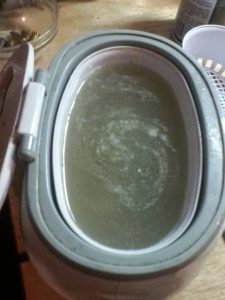
3. Scrub the top, bottom, and sides of the die with a wire brush. I spray the die down with Birchwood Casey Barricade and attack it with a steel grill brush. Others claim that brake cleaner dissolves the gunk. Scrub it up and down and diagonally, making sure to get all the rust and junk out of the grooves. Don’t forget to scrub the rings and anything else with threads as well. Get all the gunk out of the seater plug, using a toothpick or even a tiny screwdriver if stuff is really packed in there.
4. Clean out the vent hole. Many dies, especially rifle sizer dies, have a hole in the side that allows air to escape when you press the die down on to your brass. It tends to get plugged up with lube and dirt, which can damage your brass if excess air pressure cannot escape the die. Stick a toothpick in there and scrape everything out of the hole.
5. Clean the die’s interior. The easiest way to do this is to stick a soft cloth through bottom to top and run it back and forth until it comes out clean. I then push a dry rag in as far as it will go and turn the die on it until it squeaks. When you look into the die, there should be no blobs or scrapes or discolorations in the interior. Tuf-Cloth by Sentry Solutions works absolutely great for finishing this job because the non-oil coating it leaves behind prevents rust and won’t attract dust. Some people use gun patches, q-tips, and the like. Just be careful what you stick in there! Dies are made of hardened steel, but even a small scrape on this polished surface can ruin one.
6. Polish the expander ball or plug. Give pieces that must slide smoothly into the brass a good once-over with steel wool to remove any burrs or rough edges. On expander balls, you only need to polish the widest ‘ring’ on the ball, as that’s the only part that will actually come in contact with your brass.
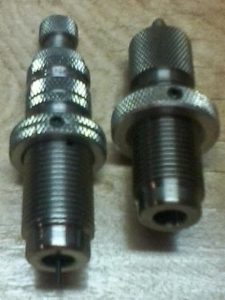
7. Rust-proof everything. Once you have stripped them of oils and waxes, dies are ripe for rust – especially if you box them up and put them out in the barn for next season. Spray everything down with a good rustproof barrier, making sure you get the threads of the rod or seater plug, and under the ball. I hit the whole die again with Barricade, but any anti-rust gun spray*** ought to work fine. There’s no need to spray inside the die if you used Tuf-Cloth, but you do want to make sure all the other parts are covered.
8. Reassemble and reinspect. Now the dies are ready for use or storage, and you won’t have a nasty surprise next time you take them out of the box.
A good set of dies should last just about forever. The die on the right, an RCBS seater in 222 Rem Mag, is 35 years old. With a good cleaning, it’s as functional as the day it was made. The Wells sizer die on the left is even older, and though it needed some replacement parts it is as ready to size brass as it ever was. Reloading dies seldom wear out from use, instead they fall prey to neglect, rust, and misuse. But take care of them and they will last you a lifetime, which hopefully will be a long, long time.
* I have no idea what it’s called. I just know I have fewer of them than I have ring screws.
** But no longer for matte-finish dies like RCBS or Hollywood. Too much time in the cleaner can discolor them.
*** Some folks swear by gun oil, and it probably protects from rust just fine. The tradeoff is that it collects dust like crazy.
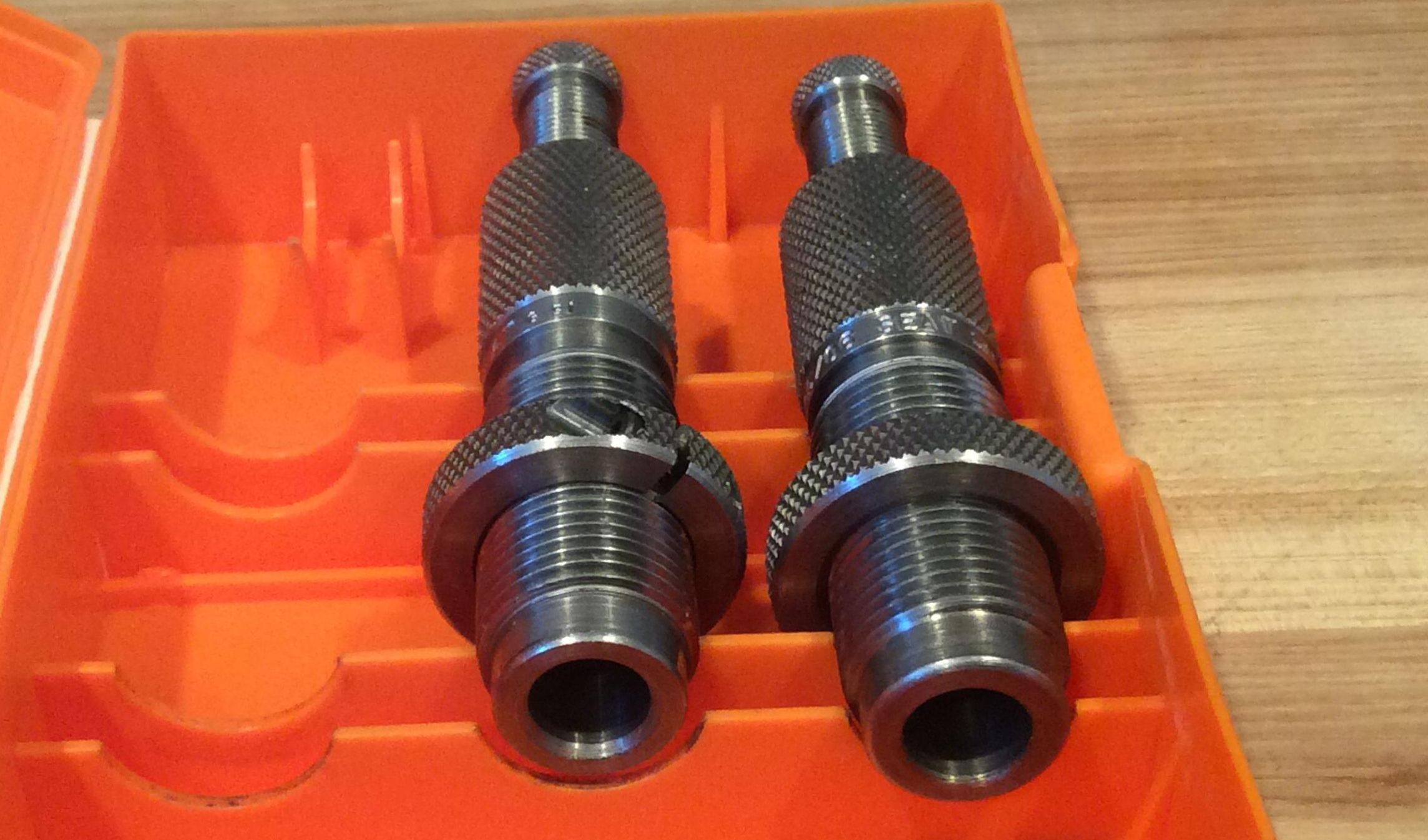
The care and feeding of reloading dies
2 Comments
Leave a Reply
Latest from Firearms

The Weimar Years – Part 5
Summary of the German Revolution, 1918-1919.

Ukraine, NATO, and the End of the Postwar Order
Russia is massing troops on the Ukrainian border. America is threatening sanctions or worse. Britain warns of war, while Germany wants peace. Is the post-WWII geopolitical order crumbling? Will Russia always be

The Commies Are Coming
The Commiecrats in congress have shifted their focus to gun grabbing. As they are writing their bill, and just a few days after a Colorado judge shot down a case that would
Molon Labe
Come and take it, you commie bastards.

One Night in San Antone: Ben Thompson (Part 2)
In the period now beginning, Ben drank more heavily than ever. He became a common nuisance to both his friends and his enemies; particularly perhaps, to his friends. Even his most indulgent




4
4.5